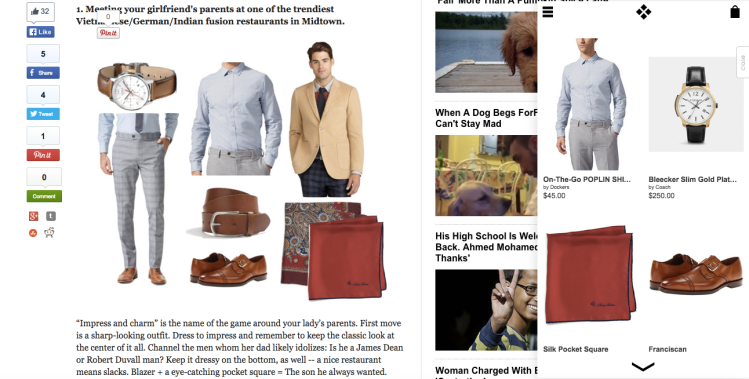The latest craze among platforms like Pinterest, Twitter, Google, and Facebook is ads that you can shop. Now, publishers are eagerly jumping on the bandwagon.
The Huffington Post is the latest to roll out a new series of ads that feature content which can be purchased directly through a pop-up shopping cart. These ‘shoppable ads’ appear as banners as well as native sponsored content. When consumers click on the ad image, a window pops out of the left-side panel, allowing them to make selections and add items to a shopping cart.
Bringhub, responsible for the shoppable ads on Zoe Report, SheFinds, and soon Bustle, is powering the experience. In total there are 20 publishers using Bringhub’s technology.
The on-boarding process is fairly simple. Publishers embed something called a “smart widget” into the header and footer of a webpage. It then scans every URL on the page, looking for product matches in its database. For items that match, the smart widget will trigger Bringhub’s shopping cart to slide out. Cofounder and CEO Dominik Pantelides said that the set up can be done in a matter of minutes.
Furthermore, publishers don’t pay a penny to use Bringhub. The company operates on a revenue sharing arrangement with retailers. Amazon, Crate & Barrel, Nordstrom, H&M, Bloomingdales, Neiman Marcus, Net-a-Porter, REI, Saks Fifth Avenue, Sephora, Topshop, Zara, and Zappos are among the brands that have shoppable ads through Bringhub. The company also has plans to expand beyond apparel and home goods.
“We’re working with one of the meal subscription services to add meal ordering on recipe sites directly into the cart,” said Pantelides. The company also has a deal with Orbitz in the works to make travel ads and deals shoppable from various publisher sites.
As mentioned earlier, Google, Pinterest, Twitter, and Facebook are all keen to better monetize ads on their platforms by making them shoppable. The added functionality could allow those platforms to take a cut of sales, rather than collecting money on clicks and views. But what few of these platforms offer is discoverability. That is to say, few people go to Facebook looking for new products to buy. That’s why Bringhub’s technology is significant; it allows users to shop at the point of discovery. Consumers are more likely to be on Zoe Report looking for a fall jacket than they are to happen upon an ad in Twitter featuring something they want to buy.
More than a just a buy button, Bringhub offers a shopping cart for the entire Web. For instance, I added a red handkerchief I found on the Huffington Post to my shopping cart and then went over to the Zoe Report. When I added a green bomber jacket to my cart, the red handkerchief was already in there, ready to be checked out. This despite the fact that I had never registered with Bringhub, Zoe Report or the Huffington Post.
Though this has terrifying implications from a privacy standpoint (How did you know it was me???), it’s a very seamless user experience, one that platform-specific buy buttons will have to contend with. Consumers need only input their information with Bringhub once before they are free to shop a variety of platforms. To buy on Google and Facebook, users will have to input data separately (which may be a hindrance to actual buying).
For consumers, the rise of the buy button is a mixed blessing. On the one hand, products are more buyable than ever. See something on your favorite blog and buy it right then and there. On the other hand, technologies like Bringhub point to the increasing number of entities that are sucking up our data — everything from shopping habits to payment credentials. The more companies consumers give their data to, the more opportunity there is to have that data hacked or exploited.
VentureBeat's mission is to be a digital town square for technical decision-makers to gain knowledge about transformative enterprise technology and transact. Learn More


